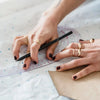Drafting Patterns for Knits vs Woven Fabrics

Many students and home sewers ask if knit and woven patterns can be interchangeable. Typically, you would not use a woven fabric for a knit pattern. However, you may use a knit fabric for some woven patterns in certain scenarios. The main thing to think about in the design process is to play to the strengths of the fabric you are using instead of forcing it to do something the fabric was not intended to do (ie. using a knit for a structural garment and vice-versa). Before we can give you a straight yes or no answer, there are several elements to consider before deciding which fabric is the most appropriate for your design.
CONSTRUCTION & CHARACTERISTICS


Let’s talk about the construction and characteristics of woven versus knit fabrics and how they affect the way each fabric fits on the body. Woven fabrics are made by interlacing two threads or fibers straight, running parallel either lengthwise (warp threads) or crosswise (weft threads). The construction method is more stable and fabrics do not give or stretch unless the fabric is woven from stretchable material, such as spandex or elastane. By contrast, knit fabrics are made by following a meandering path (a course), forming symmetrical loops (also called bights) symmetrically above and below the mean path of the yarn. These meandering loops can be easily stretched in different directions, making knitted fabrics stretch by default.
FIT
Woven fabrics need a little help in order to properly fit a three-dimensional figure from things like darts or dart equivalents like pleats, tuck darts, style lines, flares or gathers.
On the contrary, knit fabrics don’t need any darts or dart equivalents to properly fit a three-dimensional human body since their elasticity allows them to contour to the body’s outline easily. Another important point to take into consideration while drafting a pattern for knit fabrics is that even though all knit fabrics stretch, the percentage of stretch varies. Taking that into consideration, the pattern maker needs to test the stretch percentage of the knit fabric before making the pattern. Note that a knitted fabric with only 18% of stretch might need darts or , depending on the style of the garment.
WEARING EASE VS NEGATIVE EASE
When drafting patterns for woven fabrics, besides applying the measurements of the body and adding darts or dart equivalents, the pattern maker will add one or two extra inches around the circumference of the body. This is known in the industry as wearing ease and it allows the garment to move with the body.
Conversely, when drafting patterns for knit fabrics, the pattern maker will subtract a few inches from the body measurements — depending on the stretch percentage of the knit — in order for the stretch fabric to fit the body. This is called negative ease.
STRETCH PERCENTAGE AND RECOVERY

Stretch percentage is the amount of stretch per inch that occurs when the knit is stretched to its maximum length and width. stretch factor of knits ranges from 18-100% or more.
Most knits have the greatest stretch across the grain. This is the direction pattern details are laid out so that the fabric stretches across the body. That’s why percentage is usually measured across the grain.
Depending on the stretch factor there is a different percent of pattern reduction that needs to be made in order to fit the pattern accordingly. Inches need to be subtracted from the body measurements to make the pattern fit.
For example, one-way stretch stable knits with 0% – 25% stretch don’t need pattern reduction. Moderate knits need 2% pattern reduction, stretchy knits need 3.5% and super stretch knits need 5%.
The recovery factor is the degree to which a knit will return to its original shape after being stretched. Knits with good recovery return to their original length and width when released. If the fabric doesn’t return to its original or close to it, the garment will eventually sag on the body and lose some of its original .
CLOSURES
How you get in and out of a garment is a key design element. Woven garments almost always need some kind of closure, especially if it’s a fitted look. Knit clothes, on the other hand, usually don’t need closures since they have stretch. You will need to account for this in the pattern and make any necessary adjustments.
FINISHINGS
Another detail to take into consideration is the amount of seam allowance and seam finishes of the garment.
Knit garments should be sewn with an overlock or serger machine, a hem finished with a cover stitch machine. Necklines and armholes are usually finished with bias tape or binding. The amount of seam allowance added to the pattern is different from a pattern for woven fabric that can be finished on a plain stitch machine and hemmed differently.
Want to get more in-depth knowledge on knits?
Sign up for the Swimwear design course here.
Learn about knits in detail and walk out with a cute swimsuit ready for the beach!







